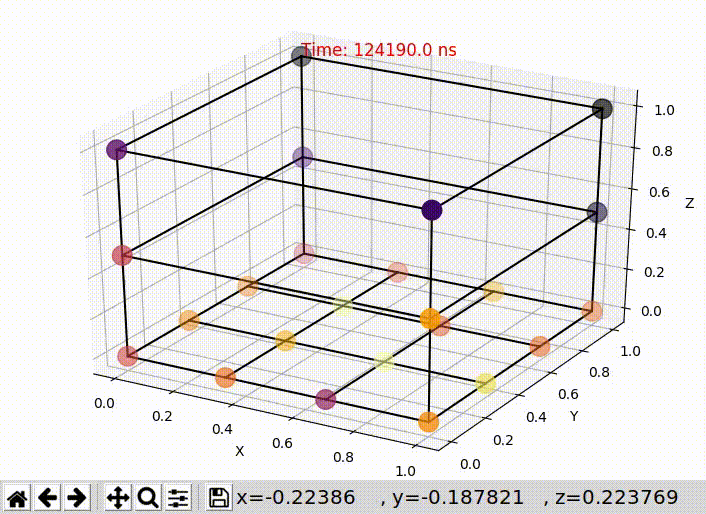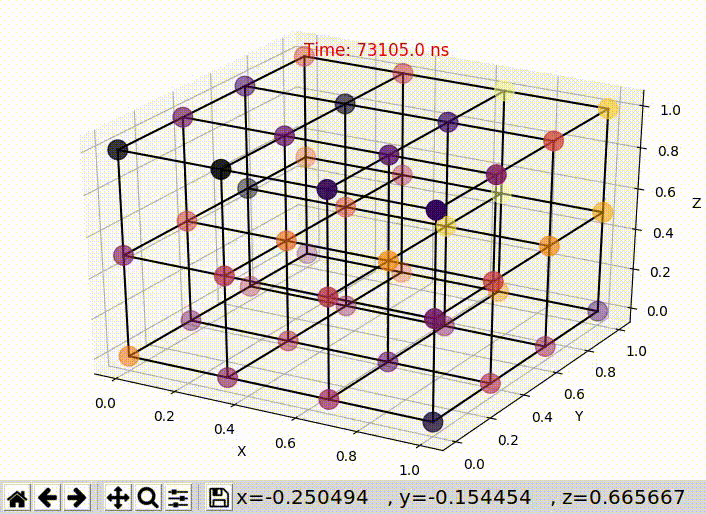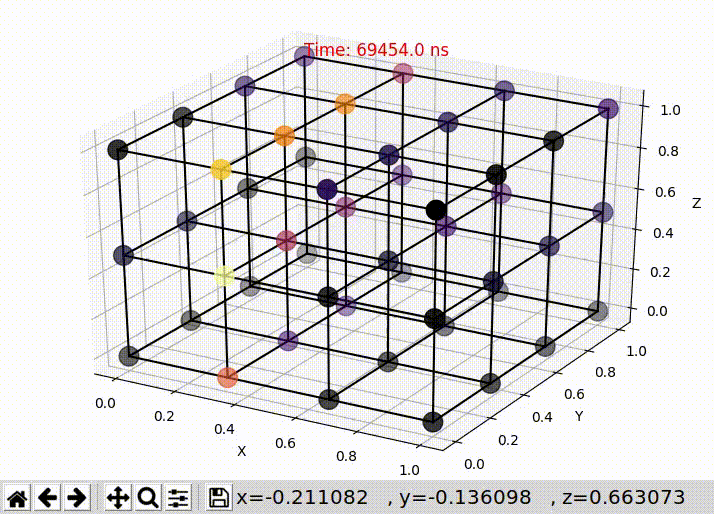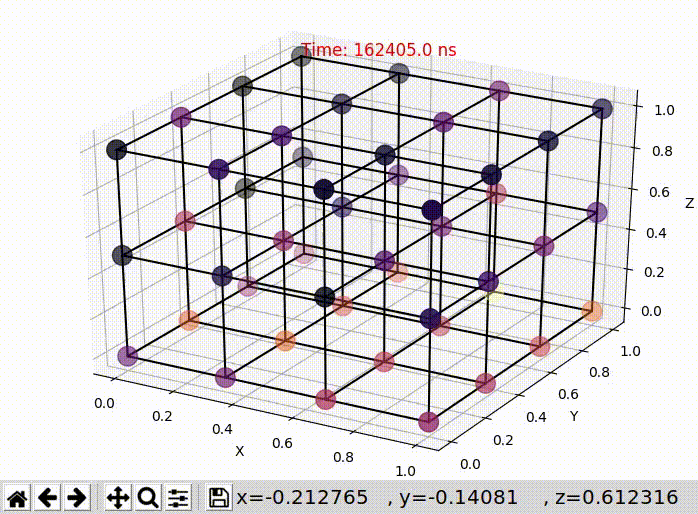Welcome to the project website of ratatoskr, an in-depth PPA framework to design NoCs. It can model 2D, 3D and heterogeneous 3D SoCs. It ships a router hardware model and precise power models. It supports uniform random traffic patterns, netrace and task graphs.
- Power estimation:
- Static and dynamic power estimation of routers and links on a cycle-accurate level.
- Accuracy of dynamic link energy is within 1% of bit-level accurate simulations.
- Performance models:
- Network performance on a cycle-accurate (CA) level using the NoC simulator.
- Network performance on a register-transfer level (RTL).
- Timing of routers from synthesis.
- Area analysis from synthesis on gate-level for any standard cell technology.
- Benchmarks:
- Netrace
- Realistic application model on transaction-level.
- Synthetic traffic patterns.
- Heterogeneous 3D Integration:
- Pseudo-mesochronous routers
- Heterogeneous network architectures.
- Reporting: Automatic generation of detailed reports from network-scale performance to buffer utilization.
Ratatoskr is developed at the RWTH Aachen University, Germany, OVG University Magdeburg, Germany and University of Bremen, Germany. It is under MIT license terms. If you use the simulator in your research, we would appreciate the following citation in any publications to which it has contributed:
@INPROCEEDINGS{7533908,
author={J. M. {Joseph} and S. {Wrieden} and C. {Blochwitz} and A. {García-Oritz} and T. {Pionteck}},
booktitle={2016 11th International Symposium on Reconfigurable Communication-centric Systems-on-Chip (ReCoSoC)},
title={A simulation environment for design space exploration for asymmetric 3D-Network-on-Chip},
year={2016},
volume={},
number={},
pages={1-8},
doi={10.1109/ReCoSoC.2016.7533908}}
How do I use PARSEC / netrace?
Documentation coming soon.
Documentation coming soon.
The name of the framework Ratatoskr is based on a squirrel from Nordic mythology. In the mythological text, the squirrel runs up and down a large tree called Yggdrasil to transport message from an eagle sitting on top of the tree to the dragon Nidhögg lying under the tree. The eagle and the dragon are quite talkative because they are in conflict. Thus, the squirrel is rather busy with its task. The inspiration of the name of our framework comes directly from the squirrels task: Just as a NoC in a heterogeneous 3D SoC, it transmits messages vertically to different senders and receivers.
Here, we provide a quick tutorial. For in-depth instructions, please visit the documentation.
Let's start simple. You can a virtualbox image from here. Boot it, login with demo/demo (user/pass). You'll find the simulator in ~/ratatoskr. We'll start from there. Let's start a terminal! (If you'd like to install the simulator on your own system, please read the detailed documentation in the docs.
cd ~/ratatoskrIn this demo system, we already installed all packages and ratatoskr, so you are ready to go. Let's first get the newest version:
git pulland compile:
cd ~/ratatoskr/simulator
./build.shAfter a short time, you'll get the executable sim. Let's run three simple examples!
In this part, we'll simulate a NoC for a heterogeneous 3D SoC with two 30nm mixed-signal layers on top an a single 15nm digital layer on bottom. We'll use XYZ routing, as published from Joseph et al. 2019, and load uniform random traffic. The result will look like this:
Let's generate this figure. Enter the demo folder and copy the executable and the configuration files:
cd ~/ratatoskr/bin/demo
cp ~/ratatoskr/simulator/sim .We'll the the python venv and copy the required files for the GUI:
cd ~/ratatoskr/bin/
make
source source_me.sh
cd ~/ratatoskr/bin/demo
cp config/network_heterogeneous.xml network.xml #will be read as network config file for plotting.
python ../plot_network_client.pyThe GUI script is started and waits for the simulation to run. Let's open a second terminal, in which you run the simulator:
cp config/config_heterogeneous.xml config/config.xml
cd ~/ratatoskr/bin/demo
./simIn this part, we'll run uniform random traffic pattern and hotspot traffic pattern and visualize the differences with our GUI. We'll use simple homogeneous networks for comparability to conventional NoCs. Copy the correct configuration files. In the config folder, you'll find the configuration of the simulator (config_homogeneous.xml) and the network, a 4 * 4 * 3 - NoC (network.xml). They are already set up for the uniform random traffic pattern. The simulation is set to 1.5M clock cycles, which will take a while. But that's enough to observe the behavior of the NoC in the GUI! Let's to that:
cp config/config_homogeneous.xml config/config.xml #for simulator
cp config/network.xml network.xml # for GUIRerun the simulation by executing python ../plot_network_client.py in the first terminal and ./sim in the second. A GUI will open and show the buffer usage in each router. It's somewhat random...!
At the end of the simulation after a few minutes, you'll see the performance results:
Generating report of the simulation run into file report ... done.
Average flit latency: 13.86 ns.
Average packet latency: 46.64 ns.
Average network latency: 46.64 ns.
Next, let's use hotspot traffic pattern. Therefore, we configure the simulator. Close the GUI by pressing q in the window or using Crtl-C in the terminal. Change line 26 of the config/config.xml file from
<phase name="run">
<distribution value="uniform"/>
<start max="1100" min="1100"/>to
<phase name="run">
<distribution value="hotspot"/>
<start max="1100" min="1100"/>Rerun the simulation by executing python ../plot_network_client.py in the first terminal and ./sim in the second. You'll recieve a rather boring but expected network load:
Let's use the heterogeneous XYZ routing, which puts more load to lower layers. This differs from conventional XYZ routing. Therefore, we reconfigure the config/network.xml by changing the router properties in lines 12, 19, and 26 from
<nodeType id="0">
<model value="RouterVC"/>
<routing value="XYZ"/>
<selection value="1stFreeVC"/>
<clockDelay value="1"/>
<arbiterType value="fair"/>
</nodeType>to
<nodeType id="0">
<model value="RouterVC"/>
<routing value="HeteroXYZ"/>
<selection value="1stFreeVC"/>
<clockDelay value="1"/>
<arbiterType value="fair"/>
</nodeType>Remember to repeat three times! Also, we'll use uniform random traffic again, so update the config/config.xml (revert the changes made before).
Finally, you'll receive the following:
For further instructions, please use our documentation. There, we also provide instrucions how to compile the simulator.
If you wish to contribute, please contact me at my univeristy email address joseph@ice.rwth-aachen.de. We offer student development jobs for students from Aachen.
The following people participated:
- Jan Moritz Joseph: Simulation tools and design optimization
- Lennart Bamberg: Physical models, hardware implementation and optimization
- Prof. Dr.-Ing. Alberto García-Ortiz: PI
- Prof. Dr.-Ing. Thilo Pionteck: PI
- Imad Hajjar: Implementation of the simulator
- Behnam Razi Perjikolaei: Implementation of the router
- Dominik Ermel: Implementation of optimization models
- Sven Wrieden: Parts of the Implementation of version 1.0
This work is partly funded by the German Research Foundation (DFG) project GA 763/7-1 and PI 477/8-1.
We are very grateful for the help of Prof. Dr. Volker Kaibel.
This simulator is available to anybody free of charge, under the terms of MIT License:
Copyright (c) 2014-2021 Jan Moritz Joseph (joseph@ice.rwth-aachen.de)
Permission is hereby granted, free of charge, to any person obtaining a copy of this software and associated documentation files (the "Software"), to deal in the Software without restriction, including without limitation the rights to use, copy, modify, merge, publish, distribute, sublicense, and/or sell copies of the Software, and to permit persons to whom the Software is furnished to do so, subject to the following conditions:
The above copyright notice and this permission notice shall be included in all copies or substantial portions of the Software.
THE SOFTWARE IS PROVIDED "AS IS", WITHOUT WARRANTY OF ANY KIND, EXPRESS OR IMPLIED, INCLUDING BUT NOT LIMITED TO THE WARRANTIES OF MERCHANTABILITY, FITNESS FOR A PARTICULAR PURPOSE AND NONINFRINGEMENT. IN NO EVENT SHALL THE AUTHORS OR COPYRIGHT HOLDERS BE LIABLE FOR ANY CLAIM, DAMAGES OR OTHER LIABILITY, WHETHER IN AN ACTION OF CONTRACT, TORT OR OTHERWISE, ARISING FROM, OUT OF OR IN CONNECTION WITH THE SOFTWARE OR THE USE OR OTHER DEALINGS IN THE SOFTWARE.




